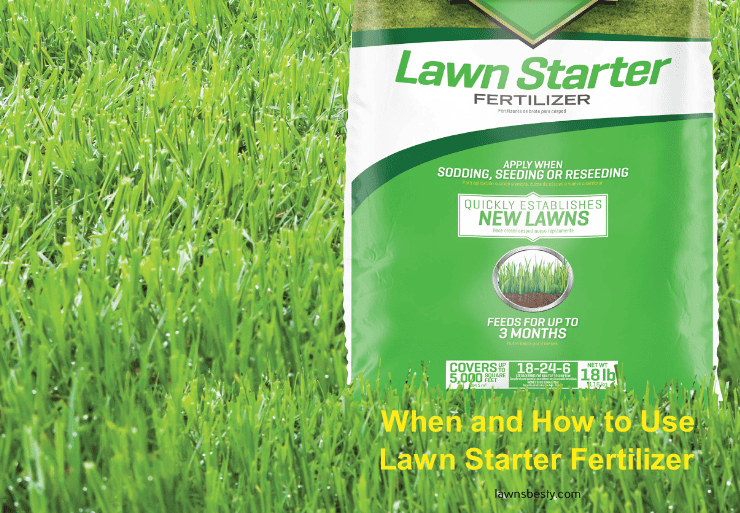Fertilizers are helpful in providing important nutrients to plants at every stage of growth. It is good to know that established and newly emerging seedlings have different nutritional requirements. This is the reason we have starter fertilizers and regular fertilizers. So, can you use starter fertilizer on an established lawn?
No, starter fertilizer should not be used on established lawns. It doesn’t contain the right nutritional value for maintaining mature grass. It is better to use well-balanced regular fertilizer that will benefit established lawns throughout the year.
Starter Fertilizer on Established Lawn – Reasons Not to Use
Lawn starter fertilizer is basically formulated for new grass seed or sod. These broad ranges of fertilizers are best applied at the seeding or sod-laying stage. When applied, starter fertilizer will help grass seedlings or sod to establish more quickly into a thick healthy lawn.
Starter fertilizers for lawns may come in different NPK ratios but they usually have balanced amounts of nitrogen, phosphorus, and potassium or contain two parts of nitrogen and one part of phosphorus and potassium. Examples of common lawn starter fertilizers are 10-10-10, 20-10-10, and 16-8-8.
Nitrogen is usually required by plants for enhanced growth and green pigmentation while phosphorous is needed for the growth of various plant tissues including roots. Potassium promotes hardiness and resistance to disease, drought, and harsh winter conditions.
At an early stage, new grass seedlings have higher requirements for energy and nutrients and thus need plenty amount of nitrogen and phosphorous which are only provided in starter fertilizers.
Using starter fertilizer on established lawns is strongly not recommended. This type of lawn fertilizer will not provide optimum and well-balanced nutrition requirements for mature grass. The higher levels of phosphorous in the fertilizer are as well not healthy for established turfs.
Excess phosphorous in the soil interferes with the absorption of nitrogen and other micronutrients such as zinc, iron, cobalt, and calcium. This will lead to stunted growth of your grass, growth of weeds, and eventually death of your grass.

Lawn Starter Fertilizer vs Regular Fertilize
Regular lawn fertilizers are designed for the maintenance of mature lawn grasses. They are usually applied throughout the year to boost the nutritional requirements of the grasses. They contain nitrogen, phosphorous, and potassium in balanced levels that benefit mature turf.
According to David M. Kopec, a turf specialist at the University of Arizona Extension, the main difference between a lawn starter fertilizer and regular fertilizer is the composition of phosphorus provided in the fertilizer. Starter fertilizers usually contain more amount of phosphorus than regular fertilizers (20% or more).
Kopec further states that quick-release nitrogen is essential in starter fertilizers. This makes it easy for young tender roots to access the nutrients. Regular fertilizer is a slow-release formula that can only benefit mature or established lawn grasses over many months.
Starter fertilizer is best applied before seeding. Using starter fertilizer directly can burn your new grass seedling or sod. Regular fertilizer on the other hand is usually applied four to eight weeks after the first application of starter fertilizer. By then, the grass is getting stronger to handle the absorption of nutrients in the fertilizer without any problem.
How do you Apply Starter fertilizer?
Before you start a new lawn or repair those bare spots, it might be important to get your soil tested. A sample of your soil should be taken to a nearby garden center or cooperative extension to determine the available amount of nitrogen, phosphorous, and potassium in your soil. This will help you choose a better starter fertilizer when you are seeding or laying sod.
If you are seeding, a starter fertilizer with closer or equal levels of nitrogen and phosphorous will be helpful. If you are laying sod, then greater amounts of phosphorous will be needed to help the cut roots establish faster. Once you have made your decision, you can now apply the fertilizer as follows:
- Carefully read and follow the application instructions on the fertilizer packaging. Ideally, apply around 0.5 to 1 pound of nitrogen per 1000 square feet. An amount more than this can burn your grass or end up in stormwater drain as a runoff.
- Apply your starter fertilizer before you lay the sod. For seeding, you can apply it before or after planting the seed. If you apply the fertilizer to newly laid sod, it could easily burn the grass especially if it’s not watered insufficiently.
- Work the fertilizer and any other recommended amendments 4 to 6 inches into the soil using a rake.
- Finally, water the planted area and cover it with a thin layer of straw or mulch to retain moisture, protect the seed from animals, and speed up the germination process. Note that, constant watering will be required for effective seed germination or establishment of the installed sod.
Once the grass is starting to grow, you can apply a regular fertilizer after 4 to 8 weeks. Preferably when the grass is 1 to 1 ½ inches tall. Once your lawn is fully established, you can now embark on the recommended yearly lawn fertilizing schedule.
Final Thought
You need to use a starter fertilizer when starting a new lawn or fixing bare spots through seeding or laying sod. A starter fertilizer is not beneficial for established lawns. Start using regular fertilizer 4 to 8 weeks after using a starter fertilizer to maintain the health of your lawn. This should be coupled with other lawn care practices including watering, mowing, and aerating.
References:
- Michigan State University, Pros and cons of granular and liquid fertilizers
- PennState Extension, Lawn Establishment